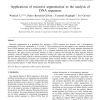Free Online Productivity Tools
i2Speak
i2Symbol
i2OCR
iTex2Img
iWeb2Print
iWeb2Shot
i2Type
iPdf2Split
iPdf2Merge
i2Bopomofo
i2Arabic
i2Style
i2Image
i2PDF
iLatex2Rtf
Sci2ools
CANDC
2002
ACM
2002
ACM
Applications of Recursive Segmentation to the Analysis of DNA Sequences
Recursive segmentation is a procedure that partitions a DNA sequence into domains with a homogeneous composition of the four nucleotides A, C, G and T. This procedure can also be applied to any sequence converted from a DNA sequence, such as to a binary strong(G+C)/weak(A+T) sequence, to a binary sequence indicating the presence or absence of the dinucleotide CpG, or to a sequence indicating both the base and the codon position information. We apply various conversion schemes in order to address the following five DNA sequence analysis problems: isochore mapping, CpG island detection, locating the origin and terminus of replication in bacterial genomes, finding complex repeats in telomere sequences, and delineating coding and noncoding regions. We find that the recursive segmentation procedure can successfully detect isochore borders, CpG islands, and the origin and terminus of replication, but it needs improvement for detecting complex repeats as well as borders between coding and no...
| Added | 17 Dec 2010 |
| Updated | 17 Dec 2010 |
| Type | Journal |
| Year | 2002 |
| Where | CANDC |
| Authors | Wentian Li, Pedro Bernaola-Galván, Fatameh Haghighi, Ivo Grosse |
Comments (0)

